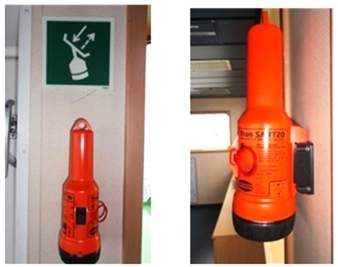With the growing technology, modern ships should have a means of automatically transmitting messages or signal in case of emergency or distress and EPIRB is one of these equipments. Let’s discuss what is an EPIRB, its different types, how it works and what are the requirements as per regulations.
TYPES OF EPIRB
- Category I EPIRB. A Category I EPIRB is designed to activate and detach from a sinking ship automatically. Typically, it is fixed onto a support on the vessel’s deck and it has a Hydrostatic Release Unit (HRU) that automatically releases the EPIRB when submerged to water and reached to a specific pressure. Furthermore, it includes a manual activation switch that can be utilized to activate the EPIRB during other emergency situations.
- Category II EPIRB. In order to use this type of EPIRB, it should be activated manually. This EPIRB can be activated either by pressing a button or pulling a pin. It can also float if dropped in water but does not have a Hydrostatic Release Unit (HRU), so it means that it will not be deployed and activated automatically during emergency such as sinking.
These two variants of EPIRB emit a 406 MHz signal consisting of a distinctive identification code and the beacon’s location. This signal is intercepted by satellites and then routed to rescue coordination centers and ground stations. Additionally, EPIRB emits a 121.5 MHz homing signal that aids rescuers in pinpointing the beacon’s position with greater accuracy. Furthermore, certain EPIRBs have an integrated GPS receiver, which improves the precision of location data.
REQUIREMENTS
SOLAS requirements
- EPIRBs are required for all ships engaged in international voyages, except for ships not propelled by mechanical means, wooden ships of primitive build, pleasure yachts not engaged in trade and those fishing boats that have a length of less than 20 meters.
- It must be registered with the national authority of the ship’s flag state, and must also be tested and maintained according to the manufacturer’s instructions and the relevant guidelines.
- It must also have a self-test function and a visual indicator of operation.
- EPIRB must be installed in a location that is easily accessible and conspicuous position on the ship, preferably on the navigation bridge or in the vicinity
- It must be capable of being manually activated by the crew or automatically activated by a hydrostatic release unit if the ship sinks.
- The EPIRB must operate on the 406 MHz frequency, which is monitored by the Cospas-Sarsat satellite system.
- It must also transmit a 121.5 MHz homing signal to help locate the position of the distress.
- The EPIRB must have a battery life of at least 48 hours at -20°C and be able to float upright in water in operational mode.
- It must also have a unique identification number and a label with the ship’s name, call sign and MMSI number.
- EPIRBs must be tested annually by an approved service provider or by the manufacturer. The test results must be recorded in the ship’s logbook and a copy of the test report must be kept on board. The test must include a visual inspection, a self-test, an activation test using a special test device and a battery replacement if necessary.
EPIRB ACTIVATION AND SAR RESPONSE
When an EPIRB is activated, either manually or automatically, it sends out a coded message with the location and identity of the vessel in distress. The message is received by satellites and relayed to the nearest rescue coordination center (RCC), which then initiates a search and rescue operation. Depending on the type of EPIRB, the signal may also include information such as the vessel’s name, call sign, registration number, and owner’s contact details. The RCC will also try to contact the vessel by radio or phone to confirm the emergency and obtain more details. The RCC will then alert the appropriate search and rescue assets, such as aircraft, helicopters, ships, or coast guard units, and direct them to the distress location. The EPIRB will continue to transmit until it is turned off or its battery runs out. The search and rescue authorities will try to locate and assist the vessel in distress as quickly and safely as possible.
Related article: What is a SART and How Does It Help in Search and Rescue Operations?





